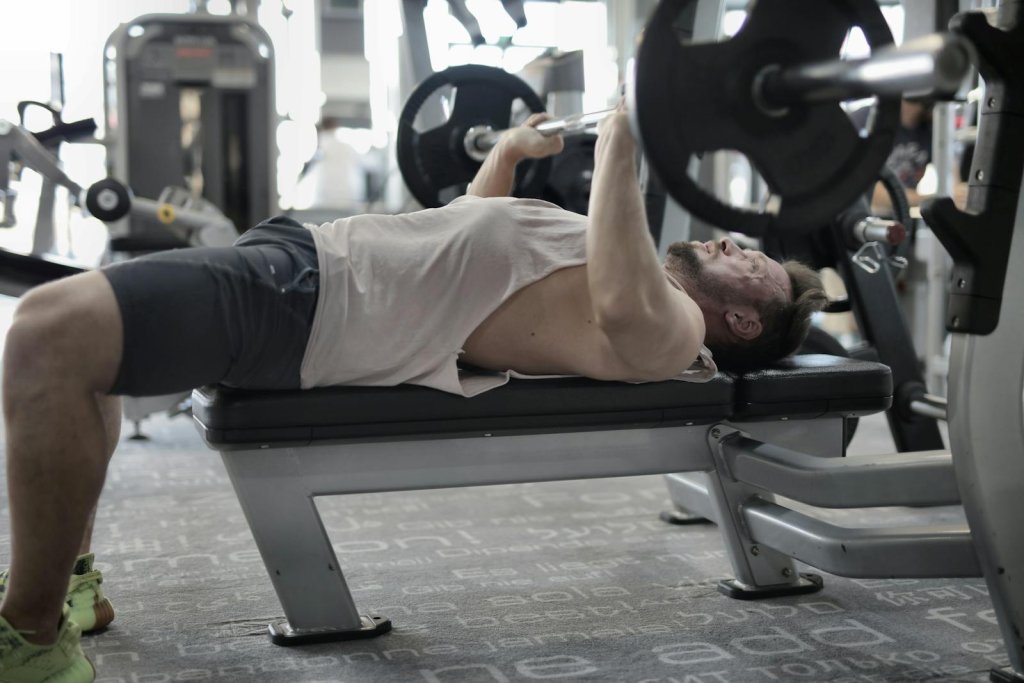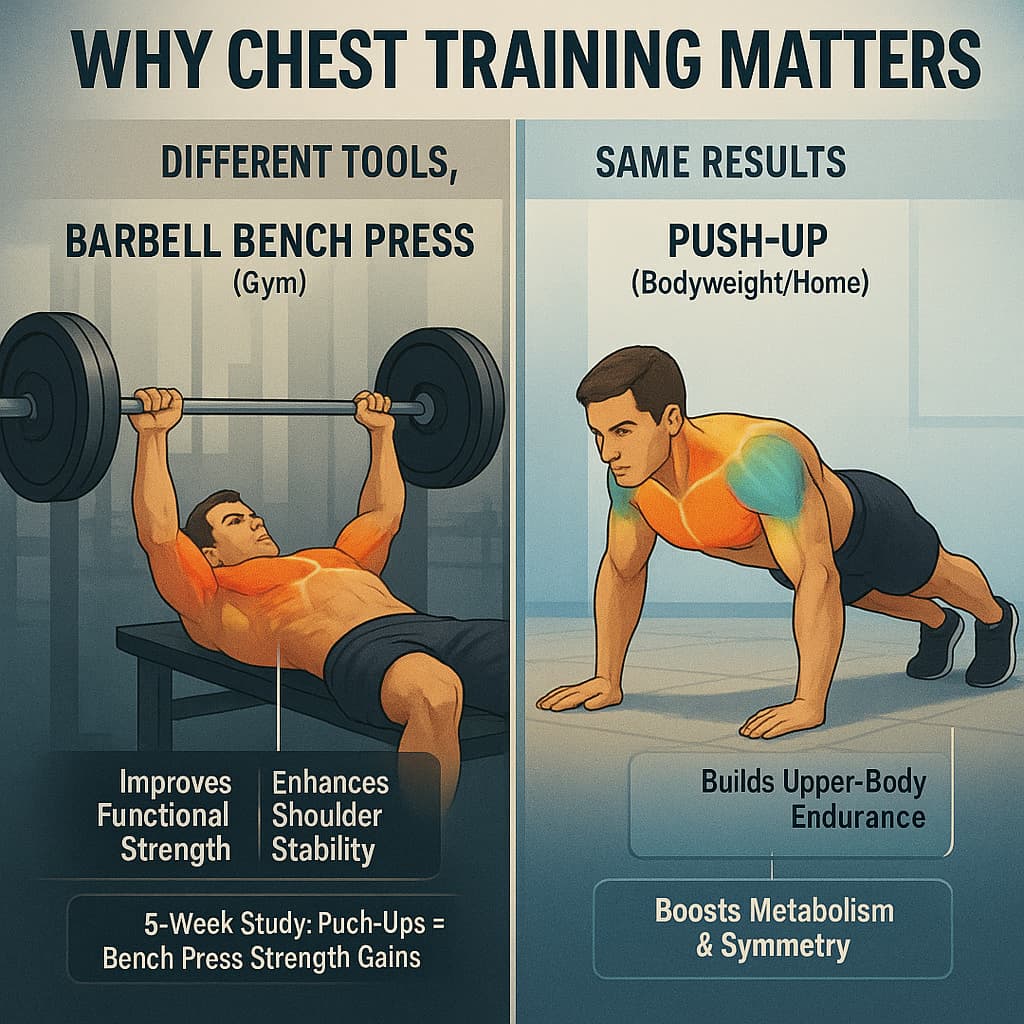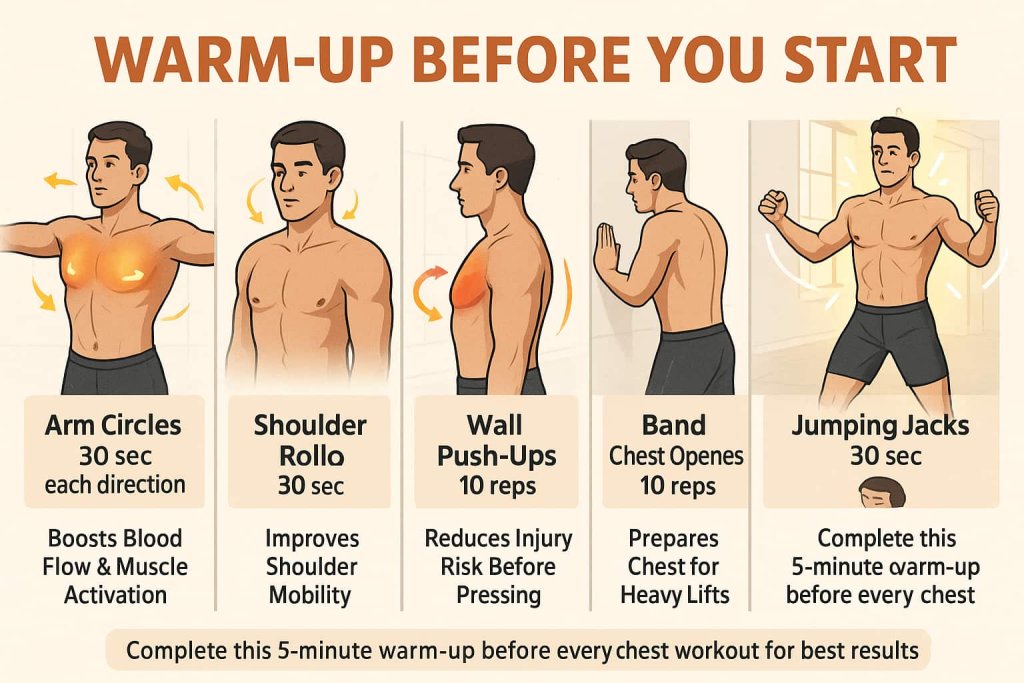The best chest exercises for men are those that combine compound presses, isolation movements, and functional variations to build strength, size, and symmetry. Developing the chest isn’t just about aesthetics—it improves posture, upper-body stability, and pushing performance in daily life and sports.

A strong chest supports the shoulders and arms, reduces risk of injury, and enhances overall athletic function. Below, you’ll find the 15 best exercises—ranging from classic barbell moves to modern cable and bodyweight options—backed by current research and expert guidance.
Why Chest Training Matters
A well-developed chest improves more than appearance—it supports functional strength and joint health. Evidence shows that consistent upper-body resistance training improves pressing strength, shoulder function, and muscular endurance. For example, elastic-band push-ups can match bench-press training for strength gains over 5 weeks, and training a muscle group twice weekly generally enhances hypertrophy compared with once weekly. (PubMed • PubMed • PMC • PMC)

Benefits include:
- Enhanced pushing strength and sports performance
- Improved posture and spinal alignment
- Increased metabolism through large-muscle activation
- Balanced upper-body development and symmetry
Anatomy of the Chest Muscles

Understanding chest anatomy helps target each region effectively:
- Pectoralis Major: The large, fan-shaped muscle responsible for most pressing and adduction movements.
- Pectoralis Minor: Lies beneath the major; stabilizes the scapula and assists shoulder movement.
- Serratus Anterior: Supports shoulder rotation and defines the chest’s side profile.
Balanced training ensures even growth across all three regions.
Warm-Up Before You Start
Warming up improves muscle elasticity and joint readiness, lowering injury risk.

5-Minute Chest Warm-Up Routine:
- Arm circles – 30 sec each direction
- Shoulder rolls – 30 sec
- Wall push-ups – 10 reps
- Band chest openers – 10 reps
- Jumping jacks – 30 sec
15 Best Chest Workouts for Men
A balanced chest workout builds strength, shape, and symmetry by targeting every section of the pectorals—from the upper fibers to the lower chest.
These 15 exercises combine power-based presses with precision isolation moves to help you build a fuller, stronger, and more defined upper body.
1. Barbell Bench Press
Why it works:
The barbell bench press remains the most effective compound lift for building upper-body strength and chest mass. It recruits multiple muscle groups, allowing you to lift heavier loads and stimulate maximal muscle fibers.
Muscles worked:
Pectoralis major, anterior deltoids, triceps brachii, serratus anterior, and stabilizing core muscles.
How to do it:
- Lie flat on a bench with feet firmly planted.
- Grip the bar slightly wider than shoulder-width.
- Lower the bar to mid-chest under control, keeping elbows at a 45° angle.
- Press the bar upward until arms are fully extended without locking out.
Trainer Tip:
Retract your shoulder blades and keep your chest lifted to protect the shoulders and increase pec engagement.
2. Incline Dumbbell Press
Why it works:
This press emphasizes the upper chest, giving the chest a fuller, lifted appearance and improving shoulder stability.
Muscles worked:
Upper pectoralis major, anterior deltoids, triceps.
How to do it:
- Adjust bench to a 30–45° incline.
- Hold dumbbells at chest level, palms forward.
- Press upward and slightly inward, bringing weights together above chest.
- Lower slowly until elbows reach a 90° angle.
Trainer Tip:
Avoid steep inclines—they shift too much stress to the shoulders and reduce chest activation.
3. Decline Barbell Press
Why it works:
The decline press targets the lower chest fibers, helping carve a stronger, more complete chest.
Muscles worked:
Lower pectoralis major, triceps, anterior deltoids.
How to do it:
- Secure your legs under pads on a decline bench.
- Grip barbell slightly wider than shoulders.
- Lower to lower-chest level, then press back up in a controlled path.
Trainer Tip:
Keep your wrists neutral and core braced—avoid bouncing the bar off the chest.
4. Dumbbell Fly
Why it works:
This isolation movement enhances chest width and definition by stretching and contracting the pectoral fibers.
Muscles worked:
Pectoralis major, pectoralis minor, anterior deltoids.
How to do it:
- Lie flat with dumbbells over chest, palms facing each other.
- Lower arms in a wide arc until you feel a deep stretch.
- Bring dumbbells back together, focusing on squeezing chest.
Trainer Tip:
Don’t lower weights too far—keep a slight bend in elbows to protect shoulder joints.
5. Cable Crossover
Why it works:
Creates constant tension across the chest, particularly in the inner region, for deep muscle engagement.
Muscles worked:
Inner and outer pectoralis major, anterior deltoids.
How to do it:
- Set cable pulleys at shoulder height.
- Step forward slightly and pull handles together in front of your chest.
- Pause briefly, then return to start with control.
Trainer Tip:
Maintain a slight forward lean and soft elbows for full contraction.
6. Push-Ups
Why it works:
A foundational bodyweight exercise that builds strength, endurance, and core stability while engaging the full chest.
Muscles worked:
Pectoralis major, anterior deltoids, triceps, core stabilizers.
How to do it:
- Start in plank position with hands shoulder-width apart.
- Lower chest toward floor while keeping elbows tucked.
- Press up until arms are extended.
Trainer Tip:
Add resistance bands or elevate feet to increase intensity.
7. Incline Push-Up
Why it works:
Ideal for beginners or active recovery—it lightens the load while maintaining full chest activation.
Muscles worked:
Upper chest, shoulders, triceps.
How to do it:
- Place hands on a bench or sturdy surface.
- Lower chest toward the surface, keeping body straight.
- Push back up, exhaling at the top.
Trainer Tip:
Keep your core tight and move slowly to maximize time under tension.
8. Dumbbell Pullover
Why it works:
Bridges chest and back training by working the pectorals and lats through an extended range of motion.
Muscles worked:
Pectoralis major, latissimus dorsi, triceps, core stabilizers.
How to do it:
- Lie perpendicular on a bench with only upper back supported.
- Hold one dumbbell above chest with both hands.
- Lower behind head in an arc, then return to start.
Trainer Tip:
Keep hips level and avoid arching your lower back.
9. Machine Chest Press
Why it works:
Offers a safe and guided movement pattern, reducing injury risk while maximizing muscle tension.
Muscles worked:
Pectoralis major, anterior deltoids, triceps.
How to do it:
- Adjust seat so handles align with mid-chest.
- Press forward smoothly, avoiding elbow flare.
- Return until elbows are slightly bent.
Trainer Tip:
Use slow, controlled reps to emphasize time under tension.
10. Pec Deck Fly
Why it works:
Isolates the chest by maintaining a strict movement path—perfect for shaping and definition.
Muscles worked:
Pectoralis major, anterior deltoids.
How to do it:
- Sit with arms bent at 90°, forearms on pads.
- Bring elbows together in front of chest.
- Squeeze at peak, then release slowly.
Trainer Tip:
Avoid jerky motions; hold for one second at the peak of contraction.
11. Dips
Why it works:
A bodyweight powerhouse for the lower chest and triceps, promoting functional strength and muscle density.
Muscles worked:
Lower pectoralis major, triceps, anterior deltoids.
How to do it:
- Grip parallel bars and lower body by bending elbows.
- Lean slightly forward to emphasize chest over triceps.
- Press back up until arms are straight.
Trainer Tip:
Avoid dropping too low—stop when shoulders are in line with elbows.
12. Single-Arm Cable Fly
Why it works:
Improves unilateral strength, coordination, and corrects muscular imbalances.
Muscles worked:
Pectoralis major (unilateral), anterior deltoid, core.
How to do it:
- Stand sideways to cable machine.
- Pull handle across your body, keeping elbow slightly bent.
- Pause at full contraction, then return slowly.
Trainer Tip:
Focus on a slow eccentric phase (2–3 seconds lowering).
13. Smith Machine Bench Press
Why it works:
Provides stability and controlled motion—great for hypertrophy and strength under heavier loads.
Muscles worked:
Pectoralis major, triceps, anterior deltoids.
How to do it:
- Lie on a flat bench under the bar.
- Unrack and lower to mid-chest.
- Press upward in a straight, smooth line.
Trainer Tip:
Use this for volume or burnout sets after free-weight pressing.
14. Stability Ball Push-Up
Why it works:
Adds instability, forcing chest and core to work harder for balance and control.
Muscles worked:
Chest, triceps, core, stabilizers.
How to do it:
- Place hands on a stability ball, feet on the floor.
- Lower chest toward ball, then press back up.
Trainer Tip:
Keep your movements slow and controlled; speed reduces effectiveness.
15. Landmine Press
Why it works:
A shoulder-friendly, hybrid press that engages the upper chest while improving pressing mechanics.
Muscles worked:
Upper pectoralis major, deltoids, triceps, core.
How to do it:
- Hold barbell at chest level with one or both hands.
- Press upward and slightly forward, extending arms fully.
- Return under control.
Trainer Tip:
Great for those with shoulder pain—keep elbows tucked close to ribs.
Safety and Precautions
- Warm up thoroughly before pressing heavy.
- Maintain proper posture—avoid flaring elbows excessively.
- Increase load gradually to prevent shoulder strain.
- Stop immediately if you feel sharp pain or instability.
How to Add These Exercises to Your Routine
For balanced growth:
- Train chest 2× per week with 3–5 exercises per session.
- Alternate heavy compound lifts and lighter isolation work.
- Aim for 8–12 reps per set for hypertrophy and 12–15 for endurance.
- Rest 45–90 seconds between sets.
Common Mistakes to Avoid
- Overtraining with too many pressing movements.
- Neglecting upper or lower chest variations.
- Using poor form or excessive arching during bench press.
- Skipping progressive overload or recovery time.
FAQs
1. How often should men train chest?
2 times per week with at least 48 hours between sessions.
2. Are push-ups enough to build chest?
Push-ups build endurance and definition but combining with weights accelerates growth.
3. Should I use barbells or dumbbells?
Both work; dumbbells offer greater range and symmetry, barbells allow heavier loads.
4. What’s the best rep range for size?
8–12 reps at 65–80% of your 1RM is ideal for hypertrophy.
5. How long until I see results?
With proper nutrition and consistency, noticeable gains appear within 6–8 weeks.
6. Should beginners use machines or free weights?
Start with machines for safety, then progress to free weights as technique improves.
7. Can I train chest and shoulders together?
Yes, but limit overlap—avoid heavy presses for both in one session.
Conclusion
Building a strong, sculpted chest requires strategic variety—mixing heavy compound lifts with focused isolation moves.
Start with foundational presses, add fly and cable work, and stay consistent. With proper recovery, nutrition, and progressive overload, you’ll build size, power, and definition that lasts.
Research References
- Incline angles boost upper-pec activation (EMG) — 30–45° incline increases clavicular pec recruitment vs. flat/steeper angles.
Effect of Five Bench Inclinations on EMG of Pectoralis Major (2020) - Push-ups can rival bench press at matched effort — Similar EMG and strength gains when intensity is equated.
Bench Press vs. Push-Ups at Comparable Muscle Activation (2015) - Push-up vs bench press mechanics/activation closely aligned — Supports bodyweight options within chest programs.
Comparison of Kinematics and Muscle Activation: Push-Up vs Bench Press (2019) - Free weights vs machines for hypertrophy/strength — Both effective; differences small when volume/intensity match.
Free-Weight vs Machine-Based Training—Systematic Review & Meta-analysis (2023) - Smith vs free-weight bench EMG — Free weights generally elicit greater shoulder/upper-body activation at similar loads.
A Comparison of Muscle Activation: Smith vs Free-Weight Bench (2010) - Dips EMG & technique insights — Bar/ring/bench dips show distinct activation; forward lean biases chest.
Bench, Bar, and Ring Dips: Kinematics & EMG (2022) - Loading for hypertrophy — Moderate loads (~60–80% 1RM; ~8–12 reps) optimize growth; heavier loads favor max strength.
Loading Recommendations for Strength & Hypertrophy (2021) - Training frequency — Working a muscle group twice per week typically yields superior hypertrophy vs once (when volume equated).
Resistance-Training Frequency & Hypertrophy—Systematic Review (2016)
